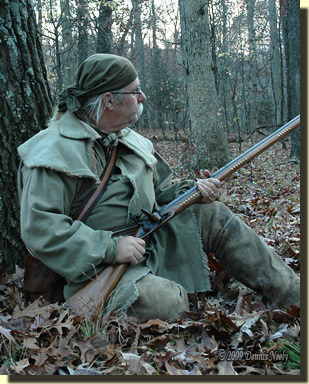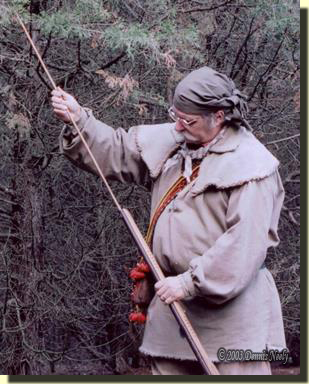“Urrr—ggoooo! Urrr—ggoooo!” Sandhill cranes sounded a warning, before first light, in the plowed plot behind the Waterman homestead. Damp elk moccasins whisked along the doe trail. A light drizzle pitter-patted. Tree-by-tree, footfall-by-footfall the earthen byway snaked through the young hardwoods. All about, last fall’s cupped leaves held tiny puddles.
The distinct smell of wet curs mixed with the freshness of awakening growth perfumed the air. Night’s abyss fought dawn’s inevitable greying. Fog hung low in the swale with the tall cottonwoods, and ahead, around the muddy watering hole. Three soggy days did not deter the quest for a wild turkey. Mid-April, in the Year of our Lord, 1793, made up for March’s drought.
Upwind, three antlerless deer meandered on the ridge crest, a few paces beyond the wild cherry that grew at an angle shallower than a brass sundial’s gnomon. The woodsman paused, letting the deer go about their morning business.
“Obl-obl-obl-obl!” A distant gobble afforded no prospect. A close-by answer never came. Then, in the distance to the southwest an unmistakable rumbling foretold of the impending downpour. The backcountry hunter glanced about and settled on a large white oak that leaned east, twelve hasty strides distant.

Three moccasin swipes cleared wet leaves, exposing damp earth. The trade blanket, rolled tight and bound with a leather portage collar, thumped beside the drier side of the big trunk. With a quick draw through the hem of his linen hunting shirt, the woodsman wiped beaded water from the Northwest gun’s browned barrel. He sat cross legged, his back tight to the tree, hunched forward with the smoothbore’s firelock tucked under his right arm.
A thumb and index finger twisted the maple peg in the cow horn’s spout, snugging it, but not tight. His left hand turned the wiping stick, pulling it an inch or so until it felt free in the forestock. The light drizzle grew into a pounding torrent. Streams of water dribbled from the oak’s upper branches, landing beyond the huddled hunter. Mist and the occasional splash struck linen and leather, but the old monarch’s eastward lean spared the full force of the deluge.
In the midst of the rainstorm, a hen turkey yelped twice, “Ark, ark…” Near the red willows that grew on the south edge of the swamp that bordered the woodlot, a gobbler answered, “Gob-obl-obl-obl!” The sage hunter considered adding a second hen’s voice, but decided against that tactic. Instead, he chose to wait.
A half hour or so later, the rain returned to the spotty drizzle of first light. Neither bird uttered another sound. With care, the woodsman got to his feet, slung the bedroll over his shoulders and ventured into the valley at the base of the hill with hopes of hiding in the tangled limbs where two hollow oaks crashed to the ground. “Maybe there,” he whispered to no one in particular…
Swollen Wood Woes
Four-plus decades ago the traditional black powder hunting bug bit hard. I was an all-weather hunter, and preferred a light rain or snow to bright sun-lit days. When I switched from the Ithaca 20-gauge to the Northwest trade gun, I never considered changing my hunting style.
Wild turkeys weren’t an option back then, so the spring rainy season wasn’t an issue, but the fall and winter had their share of wet and dismal days. I laugh now, but in those first few years, I pulled a lot of muddy messes from the breech of “Old Turkey Feathers.” Trial and error in the wilderness classroom was the best teacher, with a little guidance from Pa Keeler.
During that time, I learned that the last inch or so of the ramrod hole in the trade gun’s forestock was a tad tighter than the rest of the boring. On more than one occasion, I had to let the gun sit for a day or so in the living room corner until the swelled hickory rod eased up in the hole. Once, distraught with frustration, I destroyed the end of a rod by clamping it in my shop vice. The hickory stick didn’t budge, so I clamped it tighter, eventually crushing the brass tip and rod end—and I still had to wait for the wood to shrink on its own.
A little judicious shaving on the last couple inches of the new rod tempered the problem. Thank heavens I left the rod blank full length before adding the brass tip. I had to cut it back, because I removed too much wood. The third time was the charm. And my propensity for breaking ramrods during competitions didn’t help, either. But with experience comes knowledge.
Over the years I have broken a few powder horn stoppers, too. Two got caught in heavy brush, which had nothing to do with wood swelling. I twisted one off in the midst of a rainstorm like the April shower. I broke another on the primitive range at Friendship, the morning after a heavy shower. I should have known better…

When I clean Old Turkey Feathers, I always oil the wiping stick. I use bear grease on the powder horn stoppers. As an aside, it is now my habit to make the stoppers out of hickory or maple, left natural. I find the light wood makes the stopper easy to see in dark conditions and contrasts to the horn’s spout. Again, lessons from the wilderness classroom.
As traditional black powder hunters, we take great care in finding the optimum load for our favorite muzzleloader. We pay close attention to the gun’s idiosyncrasies and special needs. But many fall short in dealing with wood’s response to water. A swollen lock mortise can bind a sear or hamper a mainspring. A swollen ramrod makes it difficult to reload after placing a shot on a fine white-tailed buck, long-bearded gobbler or black bear. And it’s pretty tough to measure the next powder charge with a jagged stopper stump in a horn’s spout.
If we fail to account for wood’s propensity to shrink and swell, there is no point in moving to the next lair and whispering, “Maybe there…”
Give traditional black powder hunting a try, be safe and may God bless you.


